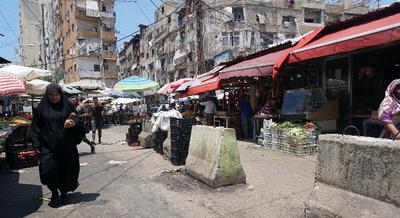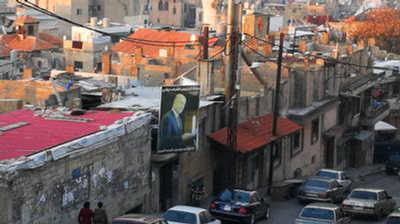Urban Displacement, Development and Donor Policies in the Middle East (URBAN3DP)
Refugees and IDPs typically settle in cities and towns, among the urban poor, yet we know very little about them.
The Middle East has one of the world’s highest levels of urbanisation, profound socio-economic inequality and is a premier displacement region. This project, Urban Displacement, Development and Donor Policies in the Middle East (URBAN3DP), seeks to investigate the key elements needed for instituting a place-centred, or area-based, urban response to refugees and internally displaced persons in the Middle East.

While the refugee camp is usually framed as the typical residence for refugees, only a minority live in formal camps. Today, refugees, migrants and IDPs typically settle in cities and towns, among the urban poor in inner-city slums and impoverished neighbourhoods, areas that can become potential poverty traps. While cities offer economic opportunities, employment and services, displacement crises often become protracted and strain local infrastructure, service provision and host communities. The majority of the Syrian refugees live in urban areas, yet little is known about their settlement choices, survival strategies and coping mechanisms. We know why, when and where refugees leave their homes, but much less about where they go after cross international and state boundaries, what guides their settlement choices and the socio-economic outcomes.
A major challenge for humanitarian policy is therefore understanding how to assist the vast number of urban displaced. Unable to address the root causes of displacement, the international community is searching for better policies to address those displacement. The UNHCR, for example, have recently reoriented its work from camps towards urban settings. This constitutes both a challenge and an opportunity as towns and cities offer better long-term integration prospects than does the traditional rural and camp-based responses.
Area-based approaches have been proposed as a potential solution that can benefit both the displaced and the host communities. By supporting both host populations and refugees, the area-based approach can reduce hostility towards refugees, provide better public services and upgrade the infrastructure to everyone’s benefit. This approach represents a shift towards participatory refugee management whereby humanitarian agencies engage national and local authorities to expand services and amenities. It is therefore particularly relevant for long-term (protracted) situations and high-need areas, such as urban displacement clusters.
This project uses area-based approaches as a starting point for formulating the primary research questions:
- Where are the displaced settling and what are the characteristics of the settlements?
- Who settles in cities and towns and why?
- What are the post-settlement outcomes?
- Which policies can support area-based solutions, considering the effects on the local/national context?
This project focuses on how to manage mass displacement and self-settlement in urban areas. In so doing, it addresses the lack of knowledge and data on those displaced in middle-income countries. We believe that future refugee policies should have a stronger focus on cities. To this end, URBAN3DP project seeks new and better ways to accommodate the urban displaced that are adapted to the present, and not tailored to past refugee crises.
Case Studies
This project focuses on the Syrian displacement crisis (2012-present). Large sections of the Syrian population are hosted indefinitely in fragile transit countries where most survive in the informal housing and labour markets. While the international aid community has faced protracted refugee situations, they have been primarily centred on camps, however, most of the displaced Syrians live in towns and cities across the region.
By analysing case studies across four host countries bordering Syria – Iraq, Jordan, Lebanon and Turkey – the project seeks a better and more nuanced understanding of regional displacement. The countries collectively host about six million Syrian refugees and have a high percentage of refugee to host populations.
Particularly, how humanitarian agencies can engage national and local authorities to expand amenities among both the urban displaced and the host population.
More specifically, the project examines eight sites across the four countries. In Iraq, we will focus on Erbil and Mosul. In Jordan, Mafraq and Zaatari (a ‘camp-city’) and in Lebanon on Beirut and Tripoli. Finally, in Turkey the project sites are Istanbul and Gaziantep.

How do we study the urban displaced?
This project uses a micro-level study of urban displacement in the sites mentioned above. This project brings together anthropologists. geographers and political scientists who all work on issues related to urban displacement and refugees in the Middle East. The team employs qualitative and quantitative methodologies, and combines different research methods in order to gain a more holistic understanding of urban displacement in the Middle East region. We aim to provide data that can be used to pilot area-based approaches and policies that can inform host states and donor communities.
The team use three main methods of research: household surveys, expert interviews and in-depth life history interviews. The survey will provide insights into settlement strategies and systematic differences across the different sites of research. The interviews allow us to capture any data excluded from the survey, including any information that survey participants may be reluctant to disclose. Through the interviews, we are able to delve deeper into obstacles to self-settlement, including issues such as access to services and amenities, housing, and barriers to education and employment.
Project progress and activities
The project launched on 15 March 2019 at a kick-off workshop and roundtable in Bergen. Since then, project researchers have been collecting surveys and data relevant to their individual city cases. Later seminars have been conducted via the web due to the COVID-19 pandemic.
Project Publications
Are J. Knudsen “Emergency Urbanism in Sabra, Beirut” in Public Anthropologist 1(2): 171-193. This paper charts the urban history of the ramshackle buildings that were once the Gaza-Ramallah Hospital, a multi-story hospital complex that was built by the Palestinian Liberation Organization (PLO). Since the 1980s, generations of displaced people have sought refuge in the buildings that now blend in with the run-down Sabra-Shatila neighbourhood in Beirut. Examining the buildings as archives of spatial and political histories can inform the study of emergency urbanism and point to solutions for urban refugees unable to access to affordable housing.
Project Highlights
Roundtable – Sanctuary in the City? Assisting Urban Refugees in the 21st Century (project team)
Blog post – Refugees in the City – a new approach to the refugee crisis
News – Completion of pre-survey field analysis in Tripoli, Lebanon
Film project – Refugees in the City
To document the living conditions for urban-based refugees and to present the project to a wider audience, the project filmed and interviewed Syrian families, shopkeepers, residents and local NGOs in collaboration with local partners in Lebanon and Jordan. The film is forthcoming in 2021.
Video – CMI Fact Find
This short video summarizes the goals of the URBAN3DP project through interviews with Sarah Tobin and Are John Knudsen, coupled with footage from project sites in Lebanon (Sabra) and Jordan (Mafraq). (Film team in Sabra, project photo, CMI)
Cities as solutions
The vast majority of Syrian refugees in Lebanon and Jordan live in urban slum areas where the infrastructure is poor, and access to schools and health services are precarious. High unemployment rates, inflation and the COVID-19 pandemic have made the situation even worse for refugees in this region. This short video, filmed on location in Sabra (Beirut) and Mafraq (Jordan) directs the attention towards some of the challenges urban refugees face, and deals with the main question in our research project URBAN 3DP (funded by the Research Council of Norway) : How can cities be part of the solution for urban refugees living in host communities where possibilities are limited?
Project Team
The project is managed by Are J. Knudsen and is based at Chr. Michelsen Institute in Bergen, Norway. Are is an anthropologist with a specialisation in refugee studies. In this project he analyses self-settled refugees in Sabra, Beirut.
Sarah A. Tobin is an anthropologist at Chr. Michelsen Institute. Her research focus is on Islam, economic anthropology, displacement and migration in the Middle East and East Africa. She is co-PI of this project and will be focusing on the Jordan case.
Tine Gade is a political scientist at NUPI, specializing in politics and state-society relationships in the Middle East. She co-leads the Iraq case in this project.
Khogir Wirya is a research fellow at the Middle East Research Institute (MERI) which is based in Iraq. His work focuses on reconciliation, with regional focus on Iraq. In this project, he co-leads the Iraq case.
Kamel Doraï is based at IFPO and is a geographer. He works on international migration and in this project will be researching the case of Jordan, particularly the Zaatari “camp-city”.
Rebecca Bryant is Professor at the University of Utrecht. She co-leads the Turkey case and coordinates research in the cities Gaziantep and Istanbul.
Ahmet İçduygu is a Professor of International Relations and Sociology and Director of Mirekoc: The Migration Research Centre at Koç University in Istanbul. He co-leads the Turkey case.
Robert Forster is the PhD candidate for the project. His research focuses on the situation for urban refugees, and in particular humanitarian programming and refugee governance in Tripoli, the second largest city in Lebanon.
Funder: Research Council of Norway (Norglobal)
Project term: January 2019 – December 2022
Advisory board: Astri Suhrke (CMI); Nasser Yassin (American University Beirut); Synne Bergby (Urban-A, Oslo); Jeff Crisp (Chatham House, London); Dawn Chatty (Refugee Studies Centre, Oxford)
Institutional partners: Chr. Michelsen Institute, Bergen (project base); Institut Français du Proche-Orient (IFPO); The Norwegian Institute of International Affairs (NUPI); The Middle East Research Institute (MERI) and Koç University










